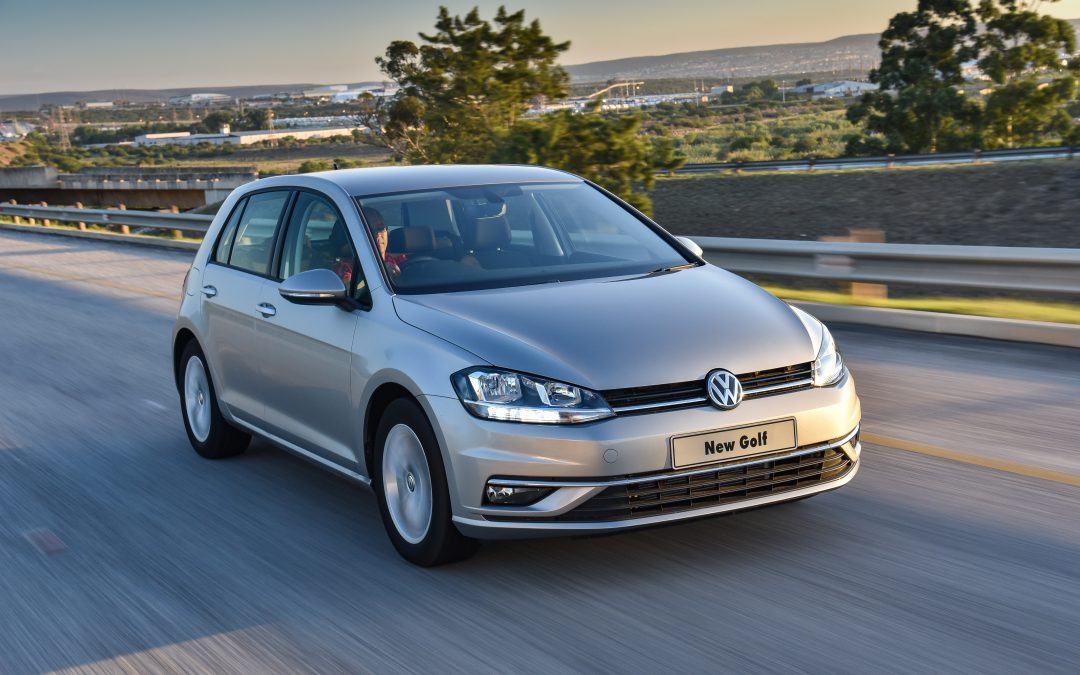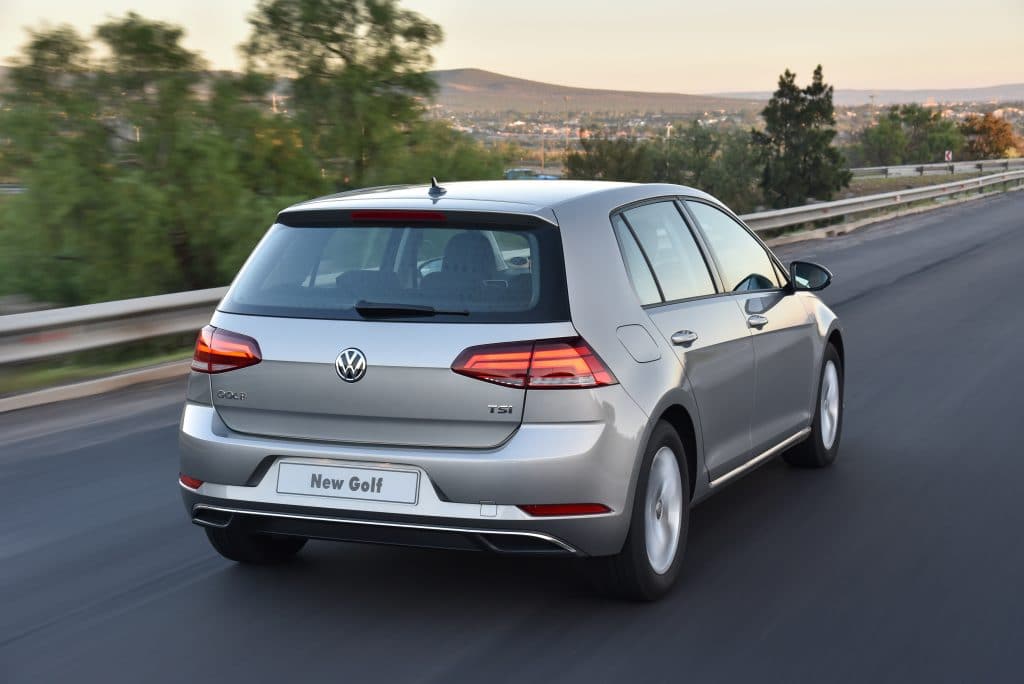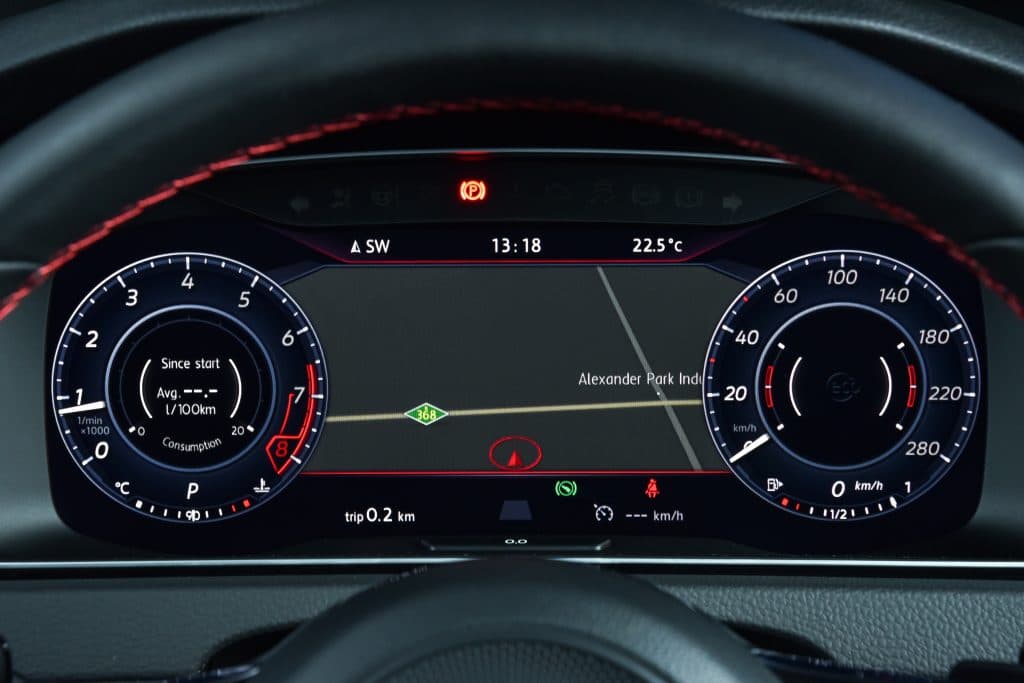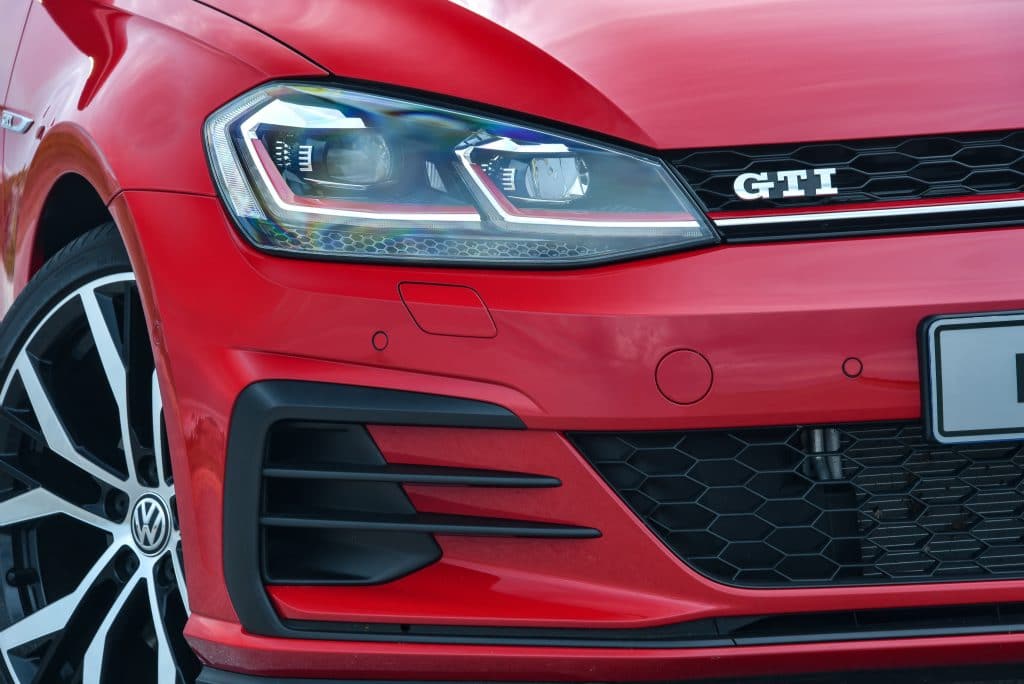VW has launched the updated Golf in South Africa, with the popular hatchback now boasting a revised engine line up, more technology, new infotainment, improved connectivity and revised styling with the retail price starting at R289 900.
At the front, the radiator grille and headlights have taken the style of its predecessor to a new level. The lower chrome strip of the radiator grille is continued to the left and right as a chrome element (GTI: chrome/red) which extends through the LED daytime running lights and into the full-LED headlights. The LED headlights in the new Golf, included as standard or as an option depending on the equipment line, replace the previous xenon headlights.
The cooling air openings in the lower section of the bumper, which have also been redesigned, emphasise the width of the Volkswagen more than ever. The radiator grilles of the non-Performance derivatives exhibit a louvretype design; on the GTI it is a honeycomb.
A key visual ‘plus’ in versions with Adaptive Cruise Control (ACC) and/or Front Assist including City Emergency Braking comes via the fact that the radar sensor in these systems is no longer visible in the cooling air intake on the bumper; rather it is now carefully hidden behind the VW badge in the radiator grille.
The rear has also been redesigned to be more charismatic. Now, all derivatives of the Golf will be equipped with full-LED tail lights. In contrast to many standard LED tail lights, none of the functions of the Golf’s new tail lights now use conventional light bulbs. Also, the GTI’s full-LED tail lights have animated, or ‘flowing’, indicator functions. Visually, this version can be recognised by a translucent white LED stripe that turns orange when indicating. Last but not least, the GTI is distinguished by a striking, dynamic visual transition between the LED tail light and the LED brake lights when the brakes are applied.
The Golf GTI can be made out by individual chrome tail pipes on the left and right.
ENGINES, TRANSMISSIONS AND RUNNING GEAR
In this first phase of the local market launch, Volkswagen is presenting the 2017 model year Golf with the following engine line up, a 1.0 TSI with 81kW, a 1.4 TSI with 92kW,and a 2.0 TSI with 169kW. The 2.0 TDI with 81kW, the Golf R with 213kW and the all-new GTD with 130kW will be introduced in the second half of the year.
Petrol engines (TSI) in detail
All the Golf’s petrol engines are turbocharged units with direct fuel injection (TSI).
1.0 TSI with 81kW. A new 1.0 TSI entry level petrol engine with turbocharging and direct fuel injection is being offered for the first time in the Golf. The 1.0 TSI has an output of 81kW and develops a torque peak figure of 175 Nm, which is particularly impressive for its engine power class. The base engine of the new Golf model range develops 81kW – as much power as the first Golf GTI from 1976. This maximum power is available from 5,000 to 5,500 rpm. The engine develops its maximum torque of 200 Nm between 2,000 and 3,500 rpm. With this engine, the Golf has a top speed of 196km/h and accelerates to 100km/h in 9.9 seconds. Combined fuel consumption is 4.9 litres per 100 kilometres. It mated to a 6-speed manual transmission.
1.4 TSI with 92kW. The 1.4-litre TSI with 92kW (5000 to 6000 rpm) has been retained. This lively engine delivers its 200 Nm maximum torque over a large speed range from 1,400 to 4,000 rpm. The Golf 1.4 TSI completes the sprint to 100 km/h in 9.1 seconds. It reaches its top speed at 204km/h while combined fuel consumption is just 5.2 l/100km.
2.0 TSI with 169kW. The iconic Golf GTI has been given more power. The new GTI now has similar power output as the outgoing GTI Performance at 169kW. The 0 to 100km/h classic sprint is achieved in 6.4 seconds and the top speed is limited to 248km/h. With DSG transmission, GTI has claimed combined fuel consumption of 6.4 l/100km.
TECHNOLOGY
Active Info Display
In combination with the display of the radio or navigation system this creates a virtual, flexible human-machine interface (HMI) whose displays complement one another. Five different views are available for the 12.3″ Active Info Display. The Golf’s Active Info Display is a fully digitalised instrument cluster with numerous interactive functions. All of the instruments are displayed virtually via software on the 12.3″ colour screen. The navigation information can be displayed in 2D or 3D. The 1,440 x 540 pixel resolution enables extremely precise and sophisticated representation of all details. There are five different information profiles, in which the kind of information and graphics displayed changes in certain areas.
The driver can select from one of the following profiles: “Classic”, “Consumption & Range”, “Efficiency”, “Performance & Driver Assistance” or “Navigation”. A good example of the interactive elements of the Active Info Display is taken from the Navigation profile. Here, the speedometer and rev counter are relocated to the sides to make more room for the navigation map in the middle. Information on driving, navigation and assistance functions can also be integrated into the graphic areas of the speedometer and rev counter, as necessary.
Data such as telephone contact images and CD covers can also be displayed in the Active Info Display. The graphics are customised according to the model. In the Golf GTI, for instance, GTI red is used as a contrasting colour. Volkswagen offers the Active Info Display as an optional extra for all versions of the Golf. (excluding Trendline models)
MIB-based infotainment
Volkswagen has replaced all previous infotainment systems in the Golf with a new generation of the MIB. All systems have a new design and larger touchscreens; however, the names of the infotainment systems have not changed.
The Composition Media previously came with a 6.5″ screen. It has been replaced by a system with the same name, but with a 8.0″ screen and a resolution of 800 x 480 pixels. Meanwhile, Composition Colour has increased its screen from 5″ to 6.5″. The top system, the Discover Navigation Pro, gets a 9.2″ screen instead of an 8″ screen; its resolution has been increased from 800 x 480 to 1280 x 640 pixels.
Composition Colour. The Composition Colour Radio/CD system is standard on Trendline and Comfortline. The sound is channelled through eight loudspeakers. Along with the SD card and AUX-IN interfaces, it also offers a USB port, and a Bluetooth connection for mobile phones.
Composition Media. The Composition Media Radio /CD system is available standard on the GTI and optional on the Trendline and Comfortline models. The design with a clear glass surface (glass design) and its integrated 8″ colour display has been completely restructured. The glass surface creates a tablet-like look. In addition to two rotary/push-button controls, the system has eight function buttons. In this system the sound (4 x 20 watts) is output over eight loudspeakers. Along with the SD card and AUX-IN interfaces, it also offers a USB port (also compatible with Apple CarPlay), a Bluetooth connection for mobile phones and a CD drive.
Discover Navigation Pro. Not only does the Discover Navigation Pro version of the MIB have a 9.2″ display with a resolution that has increased from 800 x 480 pixels to 1,280 x 640 pixels, it has also been completely redesigned. In contrast to the 8″ system that has been replaced in the Golf, the entire front is spanned by a stylish glass surface (also applies to the new Discover Navigation system).
Conventional buttons and controls are a thing of the past with the Discover Navigation Pro; manual control is performed solely via the touchscreen and five capacitive surface buttons on the left side of the new infotainment system. This vertical bar contains the functions “Menu”, “Home”, “On/Off”, “Louder” and “Quieter” – which are higher-level commands. That is because the driver should have immediate access to functions such as the volume control. The same applies to the capacitive surface button “Home”, with which the driver can return in an instant from any sub-menu to the home screen. Updates for the navigation software and a licence for “Guide & Inform” are also integrated here. In contrast to the previous version of the Discover Pro the new system offers, for the first time, a home screen that drivers can now configure. Always arranged in a large field on the left side of the display is the navigation function; on the right two smaller fields are available, one above the other. Drivers can assign functions that are particularly important to them personally to these two display panels. For instance the driver may position the radio or media library on the top panel and their phone favourites on the bottom panel.
As mentioned, the Discover Navigation Pro system may now be operated by gesture control, touch functions and voice control. Of course, the system is also equipped with a proximity sensor that makes even more menu functions appear on the display when a hand approaches the screen. Despite a range of features and functions unparalleled by previous systems, the new infotainment system’s operation remains intuitive and simple.
Gesture Control
Gesture control celebrates its world premiere in the compact class with its debut in the updated Golf. It is available with the top system of the Modular Infotainment Matrix (MIB) – the Discover Navigation Pro.
Gesture control works in various menus. A swipe gesture of the hand is all it takes to move the horizontally arranged menu items to the left or right. This enables the driver to scroll through the main menu, change radio stations, scroll forward or back through the playlist or browse in the Picture Viewer and in the music albums (CoverFlow).
A light reflex and a visualised “hand symbol” indicate the contexts in which gesture control can be used. User operation is assisted by visual interactive feedback; a successfully executed swipe gesture is also acknowledged by a sound effect, that may be deactivated. The range of equipment offered with the Discover Nav Pro system also includes an amplifier with 4 x 20 watts of output power, a DVD drive, one USB port (Apple CarPlay compatible), two SD card slots, an AUX-IN port, an SSD drive with 10 GB of storage, a full range of music playback capabilities, a movie player, jukebox, podcast player, proximity sensor, voice control as well as navigation.
Phone interfaces
Two phone interfaces are available for the new Golf. Their technical features include a digital speech processor. Together with a high-quality microphone integrated in the headlining and an interface to the outside antenna, the system guarantees very good speech quality. The standard interface is available with the Connectivity Package (including USB port) and from the Composition Media infotainment system.
Automated driving functions
If a model series has ever democratised progress, it must surely be the Golf in its first seven generations and 40-plus years. Systems such as ABS, ESC and later the whole broad spectrum of assistance systems came to be accepted as normal features by millions thanks to the affordable Golf.
It was, for example, one of the first cars in the compact class with Adaptive Cruise Control (ACC), Front Assist with City Emergency Braking, Blind Spot Monitor, Rear Traffic Alert, Park Assist, Driver Alert System, reversing camera (Rear View), and Trailer Assist.
Front Assist and City Emergency Braking
Front Assist is a system for warning the driver and braking automatically in the event of an imminent collision. One component of the Front Assist system is City Emergency Braking.
Trailer Assist
Another innovation in the compact class is Trailer Assist. Designed to free the driver of the complicated thinking needed when reversing with a car and trailer, Trailer Assist takes over instead. The system also makes reversing straight back over longer distances easier and more precise. To reverse a Golf with a trailer into a parking space or an entrance from the street, all the driver needs to do is stop at a suitable spot and engage reverse gear. The system is activated by pushing a button. Then the current driving angle and possible angles are displayed in the instrument cluster. This is achieved by image-processing algorithms that use data from the rear-view camera, which monitors and analyses the angle between the car and the trailer. By using the mirror adjustment switch, which serves as a kind of joystick, the driver can adjust the desired driving direction of the car-trailer combination.
The Golf executes the steering commands entered by the driver, who only needs to operate the accelerator pedal and the brake. The driving direction of the Golf is automatically controlled by the electromechanical power steering system.
Park Assist 3.0
In its third iteration, Park Assist now makes it possible to park semi-autonomously in any parking space that is parallel or perpendicular to the carriageway; in addition, the system can exit from parallel parking spaces. For perpendicular parking spaces, not only is parking in reverse supported for the first time in a Golf, it is also now possible to drive into a parking space semi-autonomously. The first generation of Park Assist helped the driver by performing automated steering for parallel parking. The second generation of Park Assist added automatic steering for reverse parking into spaces perpendicular to the carriageway, and it could handle smaller parallel parking spaces. In addition, automatic exiting from parallel parking spaces was also possible. The third generation of Park Assist, which is now offered in the Golf, also makes it possible to park forwards into parking spaces semi-autonomously.
STANDARD FEATURES
Trendline
The Trendline is offered with the following standard features:
Start/Stop Technology
ESP with Hill-hold assist
Electronic parking brake
Electronic adjustable heated side mirrors
Electronic windows (front & rear)
Manual airconditioner
Cloth seat covers “Basket” design
Fatigue detection
LED taillights
6.5″ Composition Colour Radio System with Touchscreen, USB, Bluetooth Connectivity and 8-speakers
15″ Lyon alloy wheels
Leather multi-function steering
LED daytime running lights
Comfortline
In addition to the Trendline standard features, Comfortline includes:
Drawer under front passenger seat
Front centre armrest
Lumbar support for front seats
Cloth seats cover in ‘Zoom’ design
Front foglights
16″ ‘Hita’ alloy wheels
Cruise control
Rain sensors
Auto-dimming rear view mirror
Auto headlights with leaving/coming home function
GTI
The standard features on GTI include:
Sport suspension
Exhaust chrome twin tailpipes (right and left)
Ambient lighting (light strips in red)
Progressive steering
18″ ‘Milton Keynes’ alloy wheels
Automatic air-conditioner ‘Climatronic’
Heated front seats
Auto high-beam
LED headlights
Dynamic cornering lights
8″ Composition Media Radio System with Touchscreen, USB, Bluetooth Connectivity and 8 speakers
App Connect
Voice Control
OPTIONAL FEATURES
The new Golf model range can be customised with a raft of convenience and comfort optional features. The optional features that are on offer include swivelling towbar, panoramic sunroof, 8.0-inch Composition Media Radio/CD system, 9.2″ Discover Pro Navigation System, Active Info Display, Rear Assist with rear view camera, Blind Spot Monitor with Rear Traffic Alert, Adaptive Cruise Control with Front Assist and Autonomous Emergency Braking System, Park Distance Control (front and rear), Park Assist, KESSY Keyless Entry and Start, Adaptive Chassis Control including driver selection (only available on GTI).
The Comfortline derivatives will be offered with an optional stylish R-Line exterior package which includes R-Line front bumper with C-signature air curtains in gloss back and air intake grille in unique honeycomb pattern. Other features of the R-Line package are 17″ Madrid alloy wheels, Rear bumper with diffuser and trapezoidal chrome trims and spoiler.
Prices (VAT and emissions tax included)
1.0 TSI 81kW Trendline Manual R289 900
1.0 TSI 81kW Comfortline Manual R304 200
1.4 TSI 92kW Comfortline DSG R356 400
2.0 TSI 169kW GTI DSG R545 800
The new Golf model range comes standard with a five year or 90 000 km Service Plan, three year or 120 000 km warranty and a 12 year anti-corrosion warranty. Service Interval is 15 000 km.
In other motoring related news, Audi South Africa’s second generation R8 Spyder recently dropped its top and hit the streets of Mzansi with its 397 kW V10 in toe.







